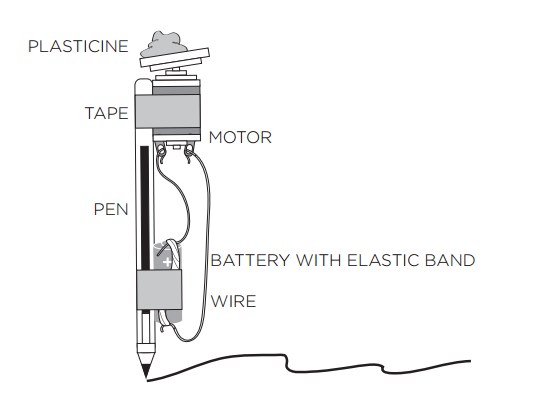In this activity, students get to set-up and connect their own electric motor, and make their own wacky pens!
Electric motors are extremely useful, and can be found in tonnes of familiar items, from blenders and mixers, to computers and cars!
In this activity, students get to set-up and connect their own electric motor, and make their own wacky pens!
Electric motors are extremely useful, and can be found in tonnes of familiar items, from blenders and mixers, to computers and cars!
Build a simple circuit to power a motor.
Per Group:
electrical tape
wire clippers
Per Student:
Mini motor
Battery
Length of covered wire (stripped at the ends, roughly the length of the pen)
Pen
Film canister lids or a 4 cm diameter circle cut from heavy cardboard (punched with a hole just large enough to fit on motor axle)
Small piece of plasticine
* Hobby motors can be purchased at hobby or electronics stores

About the sticker
Survivors
Artist: Jeff Kulak
Jeff is a senior graphic designer at Science World. His illustration work has been published in the Walrus, The National Post, Reader’s Digest and Chickadee Magazine. He loves to make music, ride bikes, and spend time in the forest.
About the sticker
Egg BB
Artist: Jeff Kulak
Jeff is a senior graphic designer at Science World. His illustration work has been published in the Walrus, The National Post, Reader’s Digest and Chickadee Magazine. He loves to make music, ride bikes, and spend time in the forest.
About the sticker
Comet Crisp
Artist: Jeff Kulak
Jeff is a senior graphic designer at Science World. His illustration work has been published in the Walrus, The National Post, Reader’s Digest and Chickadee Magazine. He loves to make music, ride bikes, and spend time in the forest.
About the sticker
T-Rex and Baby
Artist: Michelle Yong
Michelle is a designer with a focus on creating joyful digital experiences! She enjoys exploring the potential forms that an idea can express itself in and helping then take shape.
About the sticker
Buddy the T-Rex
Artist: Michelle Yong
Michelle is a designer with a focus on creating joyful digital experiences! She enjoys exploring the potential forms that an idea can express itself in and helping then take shape.
About the sticker
Geodessy
Artist: Michelle Yong
Michelle is a designer with a focus on creating joyful digital experiences! She enjoys exploring the potential forms that an idea can express itself in and helping then take shape.
About the sticker
Science Buddies
Artist: Ty Dale
From Canada, Ty was born in Vancouver, British Columbia in 1993. From his chaotic workspace he draws in several different illustrative styles with thick outlines, bold colours and quirky-child like drawings. Ty distils the world around him into its basic geometry, prompting us to look at the mundane in a different way.
About the sticker
Western Dinosaur
Artist: Ty Dale
From Canada, Ty was born in Vancouver, British Columbia in 1993. From his chaotic workspace he draws in several different illustrative styles with thick outlines, bold colours and quirky-child like drawings. Ty distils the world around him into its basic geometry, prompting us to look at the mundane in a different way.
About the sticker
Time-Travel T-Rex
Artist: Ty Dale
From Canada, Ty was born in Vancouver, British Columbia in 1993. From his chaotic workspace he draws in several different illustrative styles with thick outlines, bold colours and quirky-child like drawings. Ty distils the world around him into its basic geometry, prompting us to look at the mundane in a different way.